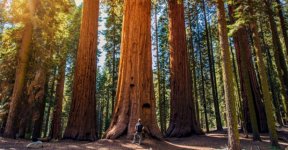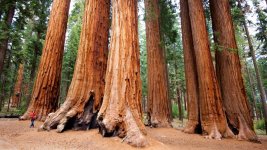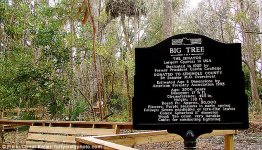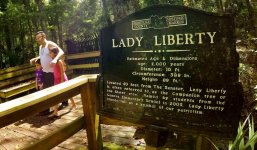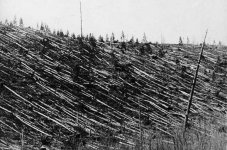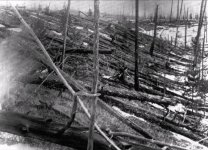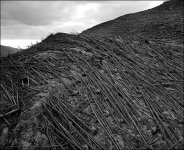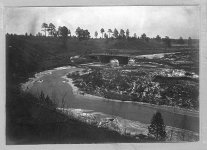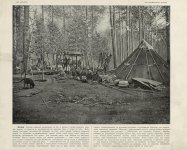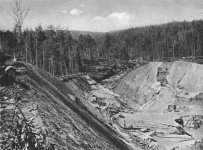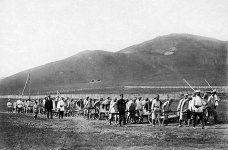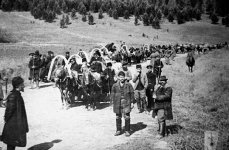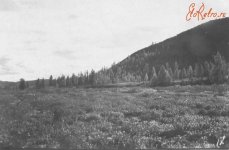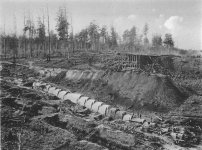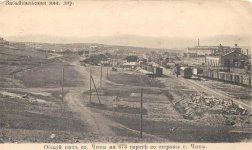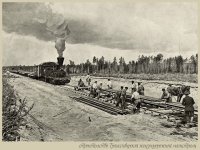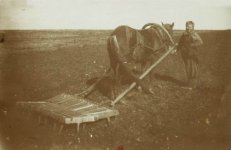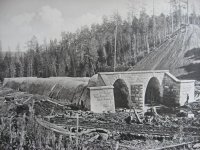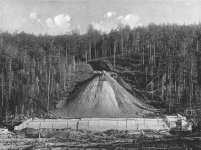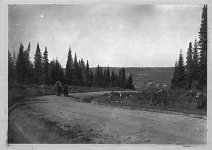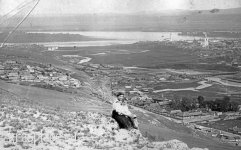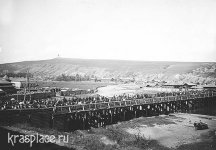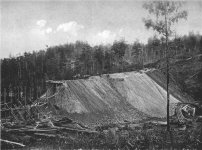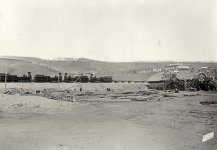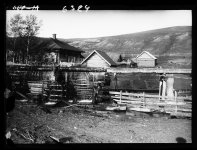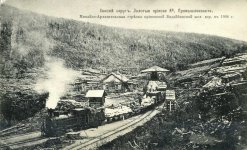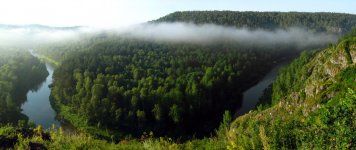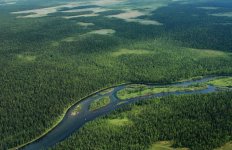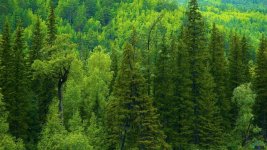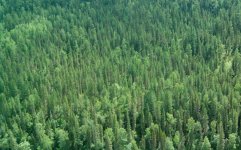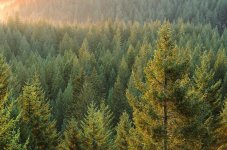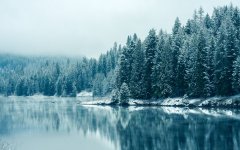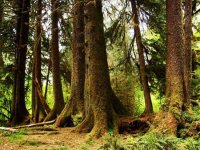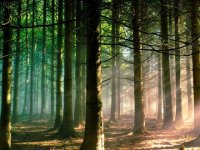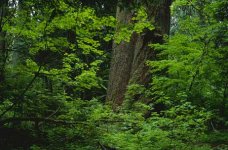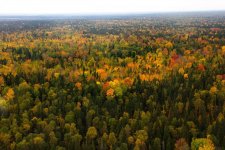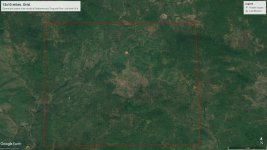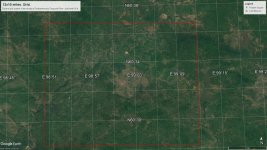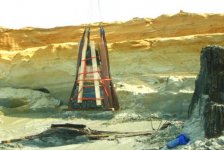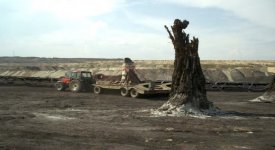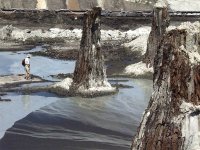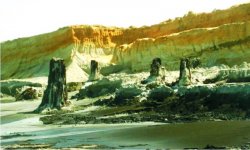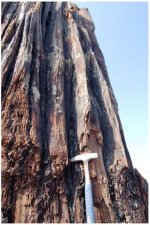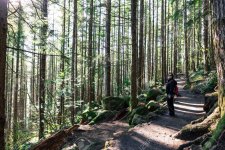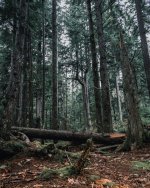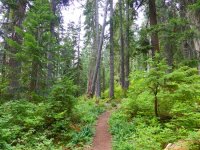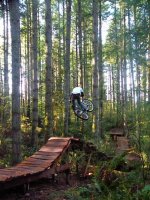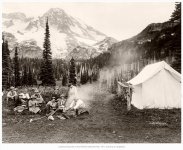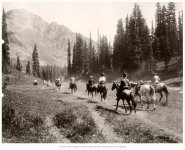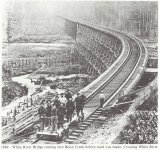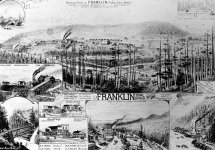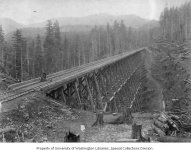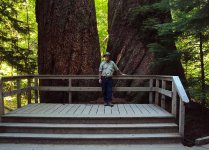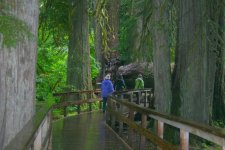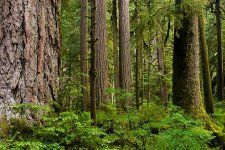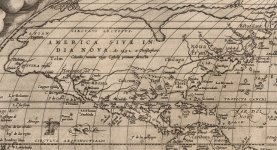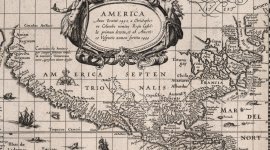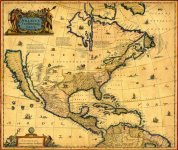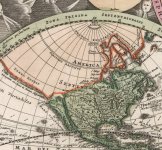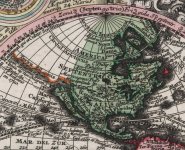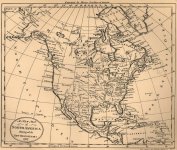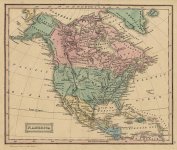This is interesting how one topic leads to another. This time I came across some information about the Siberian Taiga Forests. Apparently the age of the Siberian Forests is estimated to be around or under 200 years old. This is somewhat bizarre because the Siberian region was, for the most part, an uncharted territory well into the early stages of the 20th century. The lifetime of the Siberian Pine can reach up to 850 years. There are plenty of other trees out there whose lifespan is around 500-600 years. Yet the Siberian forests are estimated to be approximately 200 years old. This is explained by major wild fires happening from time to time.
With an area of 13.1 million square kilometres (5,100,000 sq mi), Siberia accounts for 77% of Russia's land area, but it is home to just 40 million people—27% of the country's population.

I do not think that total, human infused deforestation of such a vast region was possible in the 19th, or early 20th century. Demographic data simply does not support it. As it was mentioned above, current population of Siberia is approximately 40 million people. You can reference Geography of Siberia to see that there were barely any people out there.
Also, I think this issue of "200 year old trees" will encompass way more than just Russian Siberia. A fairly good portion of the Northern Hemisphere above, approximately, the 40th parallel north, could be affected. That I will try to elaborate on later in this article.
First thing we need to understand that areas kin to California Redwood Forests, Oregon Redwoods Trail, and Quinault Rain Forest Valley on the Olympic peninsular are rare exceptions.
There is probably a reason why the above are located within the same coastal vicinity anyways.

Also we do have some old trees in various locations, but those are single occurrences, and usually have some sort of a commemorative plaque next to them.
To gain some sort of an understanding of how old a tree is, I would like to recommend this Tree Age Calculator. It might surprise you, when you plug in the tree data on your local "big" tree. It just might be that it is only 75 years old.

Well, let's get back to the Siberian issue. We will start with the 1908 Tunguska Meteorite. The event itself is not in question here. Mind that there was no known commercial, or any other type of logging activity conducted in this remote area.

We will simply inspect some damages to the surrounding vegetation.
It can be clearly seen in the above photos that the trees in the area were fairly young in 1908. Their size uniformity indicates that they were of approximately the same age. No huge old trees can be seen. You are welcome to google-check for your self.
Now let us look at some of the photos of the Siberian region attributed to the early 20th, and late 19th centuries.
In the above photos is Russian Taiga approximately 100-120 years ago. Just below are the photos of the same vicinity but taken recently. It is estimated that an average age of the forests in Siberia is just under 200 years old.
Below you can see a tree life expectancy table I google-translated. But I do not see those 500 year old forests in the pictures above. And there can be none, because there were very young trees in Siberia in the beginning of the 20th century. If you want to see what a 500 year old tree looks like, here they are, all stand alone. They are rare and protected.


While natural explanations, like fires and logging are plausible enough, it is also naive to think that all the woods recycled themselves one way or the other. Of course for the lack of a better explanation we have to accept the "fire and logging" theory.
There is one place in Europe where multiple old trees were located. Of course our scientists assigned them a non-surprising age of 8,000,000 years old. Yes, this is supposedly the age of the stumps you can see below. They were dug out from under feet of sand and dirt in Hungary. Non-fossilized but yet they are supposed to be dinosaur old.
This way the first floors of the buildings in this article also have to be 8,000,000 years old: Mud flood, dirt rain, and the story of the buried buildings. Jokes aside, I think that a very similar "mud flood"event caused the death of these trees.
Then I googled for some pictures of Washington state, along the I-90 corridor, west of Snoqualmie.
But guess what, they are not over 200 years old either. Using the same tree age calculator, they might be close to a certain degree. I did see some bigger trees out when hiking, but they are very rare and hardly reach 300 years old. The mass is definitely within 200 years. Surely, no logging was done there 200 years ago. There could be none in 1820s.
Once again, there are some old trees, but there is no forest of old trees. If you go up higher to the Mt. Rainier National Park you can see some huge Douglas Fur trees at the Grove of Patriarchs. The area is snow free June through October, and the elevation is 2,200 feet. Some of the furs are claimed to be thousands years old. But the area where they grow is very small. It proves that old trees used to be in the area. A few survived, and the rest did not.
The uniformity of the other "all over the place" forests suggests a much younger age. Considering that the life span of the majority of the evergreens is pushing 650-900 years, this is bizarre. Of course if you do not consider another bizarre fact: the map shenanigans of the North American continent.
Below I displayed several iterations of North America as presented by our ancestors. Watch the progression from one map to the next. Time makes a huge difference.
It appears that some time ago, in the 16th century, there was a specific understanding of the outline of the North American Continent. But then something happened and the area became Terra Incognita. With time it was rediscovered and thus it reappeared on the map, this time with a differently looking outline. Could this be an event related to the other weird geographical, and urban transformations like the emergence of Sahara Desert and burial of the buildings? May be it could.
Is it possible this event killed huge tree masses in the Northern Hemisphere. I think it is.
P.S. question: do you have old forests with 500+ year old trees in your area? (forests, and not single trees)
The above explanation is very convenient for some areas, but can not account for the entire Siberian region.Periodic stand-replacing wildfires (with return times of between 20–200 years) clear out the tree canopies, allowing sunlight to invigorate new growth on the forest floor.
With an area of 13.1 million square kilometres (5,100,000 sq mi), Siberia accounts for 77% of Russia's land area, but it is home to just 40 million people—27% of the country's population.
Also, I think this issue of "200 year old trees" will encompass way more than just Russian Siberia. A fairly good portion of the Northern Hemisphere above, approximately, the 40th parallel north, could be affected. That I will try to elaborate on later in this article.
First thing we need to understand that areas kin to California Redwood Forests, Oregon Redwoods Trail, and Quinault Rain Forest Valley on the Olympic peninsular are rare exceptions.
There is probably a reason why the above are located within the same coastal vicinity anyways.
To gain some sort of an understanding of how old a tree is, I would like to recommend this Tree Age Calculator. It might surprise you, when you plug in the tree data on your local "big" tree. It just might be that it is only 75 years old.
We will simply inspect some damages to the surrounding vegetation.
It can be clearly seen in the above photos that the trees in the area were fairly young in 1908. Their size uniformity indicates that they were of approximately the same age. No huge old trees can be seen. You are welcome to google-check for your self.
Now let us look at some of the photos of the Siberian region attributed to the early 20th, and late 19th centuries.
In the above photos is Russian Taiga approximately 100-120 years ago. Just below are the photos of the same vicinity but taken recently. It is estimated that an average age of the forests in Siberia is just under 200 years old.
Below you can see a tree life expectancy table I google-translated. But I do not see those 500 year old forests in the pictures above. And there can be none, because there were very young trees in Siberia in the beginning of the 20th century. If you want to see what a 500 year old tree looks like, here they are, all stand alone. They are rare and protected.
Bizarre Fire Breaks
And than you have these bizarre fire break type perpendicular lines cut through different chunks of wilderness. And those lines do not care whether they go through a river or over a hill. They just stay straight and perpendicular to each other. I have no clue what kind of technology was used to line those up. How do you cut those through the Siberian forest, and what for? The area below is 10x12 miles, but there are tons of those. One of the images has grid lines in case you want to find it on your Google Earth.There is one place in Europe where multiple old trees were located. Of course our scientists assigned them a non-surprising age of 8,000,000 years old. Yes, this is supposedly the age of the stumps you can see below. They were dug out from under feet of sand and dirt in Hungary. Non-fossilized but yet they are supposed to be dinosaur old.
This way the first floors of the buildings in this article also have to be 8,000,000 years old: Mud flood, dirt rain, and the story of the buried buildings. Jokes aside, I think that a very similar "mud flood"event caused the death of these trees.
Then I googled for some pictures of Washington state, along the I-90 corridor, west of Snoqualmie.
But guess what, they are not over 200 years old either. Using the same tree age calculator, they might be close to a certain degree. I did see some bigger trees out when hiking, but they are very rare and hardly reach 300 years old. The mass is definitely within 200 years. Surely, no logging was done there 200 years ago. There could be none in 1820s.
Once again, there are some old trees, but there is no forest of old trees. If you go up higher to the Mt. Rainier National Park you can see some huge Douglas Fur trees at the Grove of Patriarchs. The area is snow free June through October, and the elevation is 2,200 feet. Some of the furs are claimed to be thousands years old. But the area where they grow is very small. It proves that old trees used to be in the area. A few survived, and the rest did not.
The uniformity of the other "all over the place" forests suggests a much younger age. Considering that the life span of the majority of the evergreens is pushing 650-900 years, this is bizarre. Of course if you do not consider another bizarre fact: the map shenanigans of the North American continent.
Below I displayed several iterations of North America as presented by our ancestors. Watch the progression from one map to the next. Time makes a huge difference.
It appears that some time ago, in the 16th century, there was a specific understanding of the outline of the North American Continent. But then something happened and the area became Terra Incognita. With time it was rediscovered and thus it reappeared on the map, this time with a differently looking outline. Could this be an event related to the other weird geographical, and urban transformations like the emergence of Sahara Desert and burial of the buildings? May be it could.
Is it possible this event killed huge tree masses in the Northern Hemisphere. I think it is.
P.S. question: do you have old forests with 500+ year old trees in your area? (forests, and not single trees)


